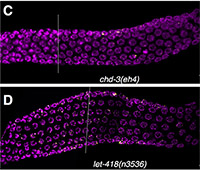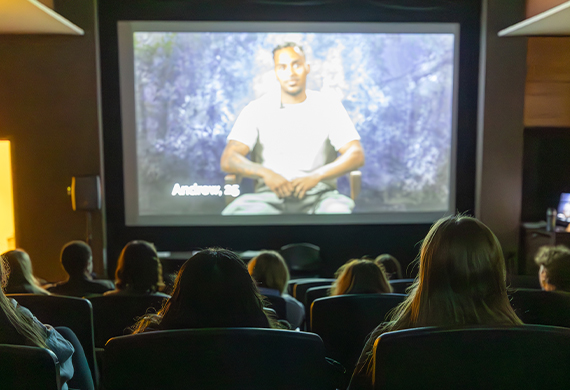On the Ground Floor of Discovery
(L-R) Aidan Nowkowski '20, Alexandra Northrup '20, Beatrix Bradford '19, Carolyn Turcotte '18, Professor Paula Checchi, Julia Rigothi '17, Julia Laibach '18, Erika Rosenkranse '19, Professor Nicolas Andrews. (Not pictured: Solomon A. Sloat '17, Richard Monsky '20, and Alexa Peruffo, Arlington High School '18)
February 28, 2018—When an enterprising freshman walked into Paula Checchi’s office in 2015, the Assistant Professor of Biology had no idea the meeting was going to steer the course of a multi-year research project that would lead to getting an article published in the prestigious journal Genetics. (Read the full Genetics article.)
The student was Carolyn Turcotte ’18. Checchi says Turcotte stood out because “most of the students I meet want to be doctors,” she recalled. “Carolyn walked into my office and said she wanted to work on a project and that her goal was to run a genetics research lab.”
Turcotte said Checchi responded immediately and enthusiastically, telling her she had an opening in her lab. This would lead to a four-year collaboration in and out of the lab, with Checchi also serving as Turcotte’s advisor and mentor.
A Discovery
Checchi had a project in mind for Turcotte. A geneticist, she had been looking into how DNA damage can disrupt fertility. She asked Turcotte to run experiments on a gene called chd-3 that is present in multiple organisms, including humans. Checchi admits [Genetics Research microscope] that the literature on chd-3 showed nothing remarkable, but she thought the project would be good for Turcotte. However, Turcotte made an interesting discovery not found in any previously published work: nematode worms without chd-3 had fewer offspring.
This key finding set Checchi and her other research students on a new path. Working with Visiting Assistant Professor of Biology Nicolas Andrews, a molecular biologist with expertise in working with antibodies and proteins, Checchi used funds from her National Institutes of Health (NIH) grant to continue the work.

DNA, Worms, and People
“I have a particular interest in human health and disease,” said Checchi. “I want to use genetics to eventually have a positive impact on people. This project is so rewarding because it shows how DNA repair can have a direct impact on fertility.”
The team worked with nematode worms, which have six chromosomes, making them manageable for genetics research. Andrews and his student researchers created mutant worms and observed their characteristics. “Certain proteins are activated when there is DNA damage,” Andrews explained.
Over the course of more experiments, Checchi and her team of students found that chd-3 is needed for successful meiosis, the process of making egg and sperm. The team’s findings also have implications for cancer since the repair pathways in damaged germ cells are similar to those in somatic cells found in the rest of the body.
Checchi explains the role of labs like hers. “We’re at the ground level of work in a lab like this, the base of the pyramid. The hope is that our findings, combined with the findings of other researchers, can be used to inform and develop treatments further up the pyramid. The kind of work that happens in research labs is essential to human health.”
Great Opportunity for Undergraduate Research
The group’s work will be published as a feature article in the March issue of Genetics, a peer-reviewed journal with international reach. Checchi is thrilled with the team’s accomplishment and is committed to continuing to provide undergraduate research opportunities.
“It’s terrific to see this article being published, and I’m pleased to note that every co-author is connected to Marist—students, alumni, and faculty,” she said. “We don’t often think of liberal arts colleges as being at the forefront of scientific research, but there are strong opportunities for undergraduates in this setting that they might not get at a larger university.”
Turcotte came to Marist knowing she wanted to study science. “I love the puzzles in the work,” she said. “There are twists and turns in research and you see what emerges.” Her dedication to her studies has paid off: last year, Turcotte was the recipient of a nationally competitive Goldwater Scholarship, the most prestigious award given to students studying in STEM fields.
What’s Next
Checchi hopes to renew the NIH grant and explore how chd-3 and other genes can protect cells, while Turcotte, who will graduate in May with a dual major in Biochemistry and Biomedical Sciences, is in the process of choosing a doctoral program in genetics. As of this writing, she has been accepted to Harvard, Johns Hopkins, Emory, and numerous others.
“I would like to be in Dr. Checchi’s shoes at some point,” Turcotte enthused. “Running a research lab and coming up with the direction of the work. That’s my goal.”
About Marist
Located on the banks of the historic Hudson River and at its Florence, Italy branch campus, Marist College is a comprehensive, independent institution grounded in the liberal arts. Its mission is to “help students develop the intellect, character, and skills required for enlightened, ethical, and productive lives in the global community of the 21st century.” Marist is consistently recognized for excellence by The Princeton Review (Colleges That Create Futures and The Best 381 Colleges), U.S. News & World Report (9th Best Regional University/North), Kiplinger’s Personal Finance (“Best College Values”), and others. Though now independent, Marist remains committed to the ideals handed down from its founders, the Marist Brothers: excellence in education, a sense of community, and a commitment to service. Marist educates approximately 5,000 traditional-age undergraduate students and 1,400 adult and graduate students in 47 undergraduate majors and 14 graduate programs, including fully online MBA, MPA, MS, and MA degrees.



